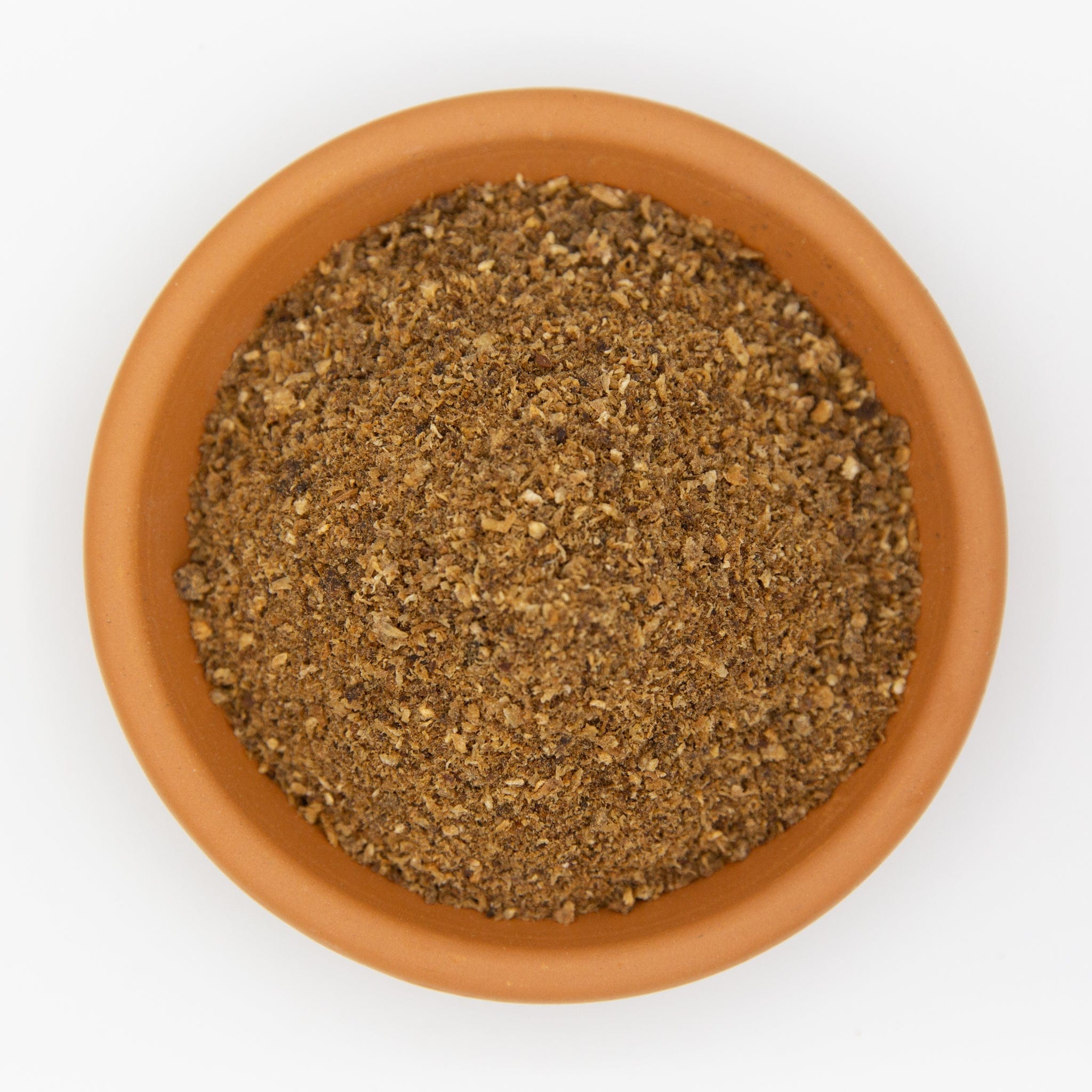Coconut meal is the coconut flesh that's been dried and ground after removing the high oil content.
With a 3% potassium content, our coconut meal can be used as an effective pre flower top dress or use to produce an amazing potassium loaded compost. Soil microbes and fungi love coconut meal and we recommend mixing it with compost and rock dust and then into the top layer of your soil 2-4 weeks before planting. However can be applied throughout the growing season with no issues.
Use 1/2 cup per 30L or meter squared.
Other advantages:
- Packed with organic matter, nitrogen, potassium, and other micronutrients vital to the health and growth of plants.
- Enhances soil health and fertility by incorporating necessary nutrients and encouraging the development of advantageous microbes.
- Can be utilised to increase plant yield and general health.
- Can be utilised as a natural source of nutrients with a delayed release.
- Can be used to make nutrient-deficient soils more fertile.
- Can aid in improving soil water retention.

FAQs:
What is Coconut Meal?
Coconut Meal is dried, defatted coconut flesh that’s been ground to a meal. It’s a natural, slow-release soil amendment that adds organic matter and—crucially—potassium for flowering and fruiting.
What’s the actual potassium content?
Roughly 3% potassium by weight. It’s designed to nudge K without blasting your soil like straight potash would.
What does Coconut Meal do for plants, practically?
Helps drive strong flowering/fruiting, improves overall plant health, feeds soil microbes, and adds organic matter for better structure and moisture holding.
When should I use Coconut Meal—veg or bloom?
Anytime, but it shines pre-flower through bloom when plants are hungriest for potassium.
How do I apply Coconut Meal to garden beds?
Top dress or mix into the top layer at about ½ cup per 30 L of soil or per square metre. Water in.
How far in advance should I add Coconut Meal before planting?
If you’re prepping a new bed or pot, mix it with compost and a rock dust and incorporate 2–4 weeks before planting to let microbes wake up and start cycling nutrients.
Can I just top dress mid-season?
Yep. You can apply through the growing season with no issues—light, regular top dresses are the way.
How often should I reapply?
Every 3–6 weeks during heavy growth or flowering is a good cadence. Aim small and frequent rather than one big dump.
What’s the best way to blend Coconut Meal?
Stir it into finished compost, then spread and scratch into the top 3–5 cm of soil. Follow with a mulch to keep it moist and microbe-friendly.
Will Coconut Meal burn plants?
Not at recommended rates. It’s a gentle, slow-release organic input.
Is Coconut Meal okay for seedlings?
Yes—use sparingly. Mix into the medium at ¼–½ strength or top dress a pinch around the seedling away from the stem.
What about potted plants?
Same rate: ~½ cup per 30 L of potting mix. For smaller pots, think teaspoons to tablespoons depending on size.
Does Coconut Meal change soil pH?
It’s generally mild and pH-neutral in effect. Don’t rely on it for pH adjustment.
How fast does Coconut Meal work?
Think weeks, not days. It’s microbially mediated and trickle-feeds K as it breaks down.
Can I brew Coconut Meal into a compost tea?
You can, but go easy—fine meals can go anaerobic if you overload the brew. If you do it, use a small amount and lots of aeration, then apply immediately.
Is Coconut Meal suitable for hydroponics?
No. It’s a particulate, organic amendment—great in living soil and compost, not for recirculating systems or drip lines.
Will Coconut Meal help sandy soils?
Yep. It adds organic matter and improves water retention, which sandy mixes desperately need.
Any benefit in clay soils?
Also yes. Organic matter helps aggregation and improves aeration and drainage over time.
Can I use Coconut Meal in a worm farm or compost?
Absolutely—worms and microbes love it. Sprinkle lightly and mix with browns to avoid heating or clumping.
Does Coconut Meal smell or attract pests?
It has a mild, nutty/earthy smell. If you leave it on the surface in thick piles, it can invite curious critters—scratch it in and mulch to keep it tidy.
Is Coconut Meal the same as coconut coir?
No. Coir is the fibrous husk used as a substrate. Coconut Meal is the ground, defatted kernel flesh used as a nutrient amendment.
What’s the difference vs straight Potash (0-0-41)?
Potash is a fast, concentrated potassium salt. Coconut Meal is gentle, slow-release K plus organic matter and microbe food. Use Meal for long-term soil health; use Potash when you need an immediate K correction.
Can I combine Coconut Meal with other DRGT amendments?
Yep—pairs beautifully with compost, rock dusts (Azomite/Volcanic/Palagonite), Kelp Meal, Neem/Alfalfa meals, and our Bud & Bloom blends for a full spectrum.
Will Coconut Meal replace a complete fertiliser?
No. It’s a K-leaning amendment. Keep a balanced base nutrition program (e.g., complete organic fertiliser) and use Coconut Meal to bias toward potassium.
What plants benefit most?
Heavy bloomers and fruiters: tomatoes, capsicum, chillies, cucurbits, berries, roses, cannabis, citrus, and ornamentals that pop flowers hard.
Is there sodium in Coconut Meal like some coconut products?
Ours is the defatted kernel meal, not salty coir brine. It’s suitable for garden use at the recommended rates.
Will Coconut Meal go rancid?
The high oil content has been removed—that’s the bit that goes off—so shelf life is solid if you store it right.
How should I store Coconut Meal?
Cool, dry spot, sealed bag or tub. Keep moisture out to prevent caking and to deter pantry moths.
Is Coconut Meal pet-safe?
It’s a natural plant input. Keep the bag out of reach (some pets think everything is a snack), and avoid letting animals eat the meal straight.
Can I overdo Coconut Meal?
Yes—more isn’t more. Over-amending with any single nutrient can skew balance. Stick to the rates and keep an eye on overall NPK.
How do I know if my plants need more potassium?
Common signs include weak flowering, poor fruit set, marginal leaf scorching, and floppy growth. A soil test is the cleanest way to confirm.
Does Coconut Meal contain nitrogen or phosphorus too?
There’s a small background of N and traces of P, along with micronutrients—but think of it primarily as a potassium + organic matter input.
Can I use Coconut Meal as a lawn top dress?
You can, but lawns often prefer balanced N-forward feeds. If you try it, apply lightly and water in well.
Any compatibility issues with microbes or mycorrhizae?
No—if anything it feeds the soil food web. It plays nicely with inoculants and living soils.
What’s the application rate again?
~½ cup per 30 L of soil or per m². Light, repeat applications during the season are better than one heavy hit.
Got a simple program for flowering veggies?
Sure: balanced organic base → light top dress of Coconut Meal at first bud set → repeat every 4–6 weeks → keep soil mulched and moist → finish with a last light top dress early in peak bloom.
What should I pair Coconut Meal with for best results?
Compost (biology), a rock dust (trace elements), and kelp (biostimulants). That trio + Coconut Meal is a killer bloom foundation.
Can I dissolve Coconut Meal and use it via a watering can?
It won’t truly dissolve. If you want to “water-in,” pre-mix the meal with compost or worm castings, then top dress and water thoroughly so microbes can do the work.
Will Coconut Meal stain patios or hands?
It’s a brown meal—sweep up spills and wash hands after use. It’s not tarry or oily.
Is Coconut Meal organic?
It’s a natural plant-derived amendment. No synthetic salts added.
What sizes does Coconut Meal come in and what do they cover?
500 g, 1 kg, and 2.5 kg. As a rough guide at ½ cup per m², 1 kg covers ~10–15 m² depending on how generous your scoop is.
Any “don’ts”?
Don’t use it in recirculating hydro, don’t bury huge amounts in seedling trays, and don’t dump piles on the soil surface—scratch in and mulch.
Quick start summary?
Mix a little into compost, scratch into the top of your bed or pot (½ cup per 30 L/m²), water, mulch, and re-apply lightly every few weeks through bloom. That’s it.



